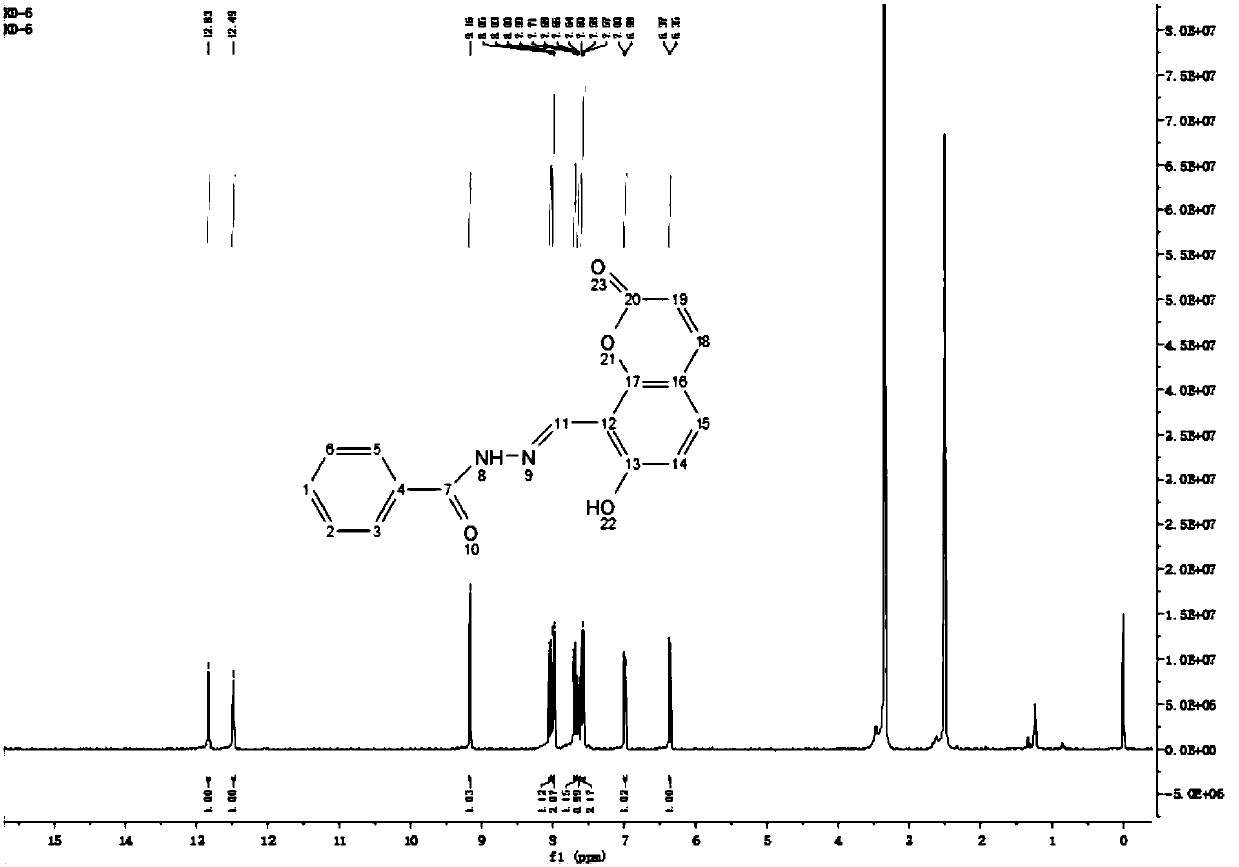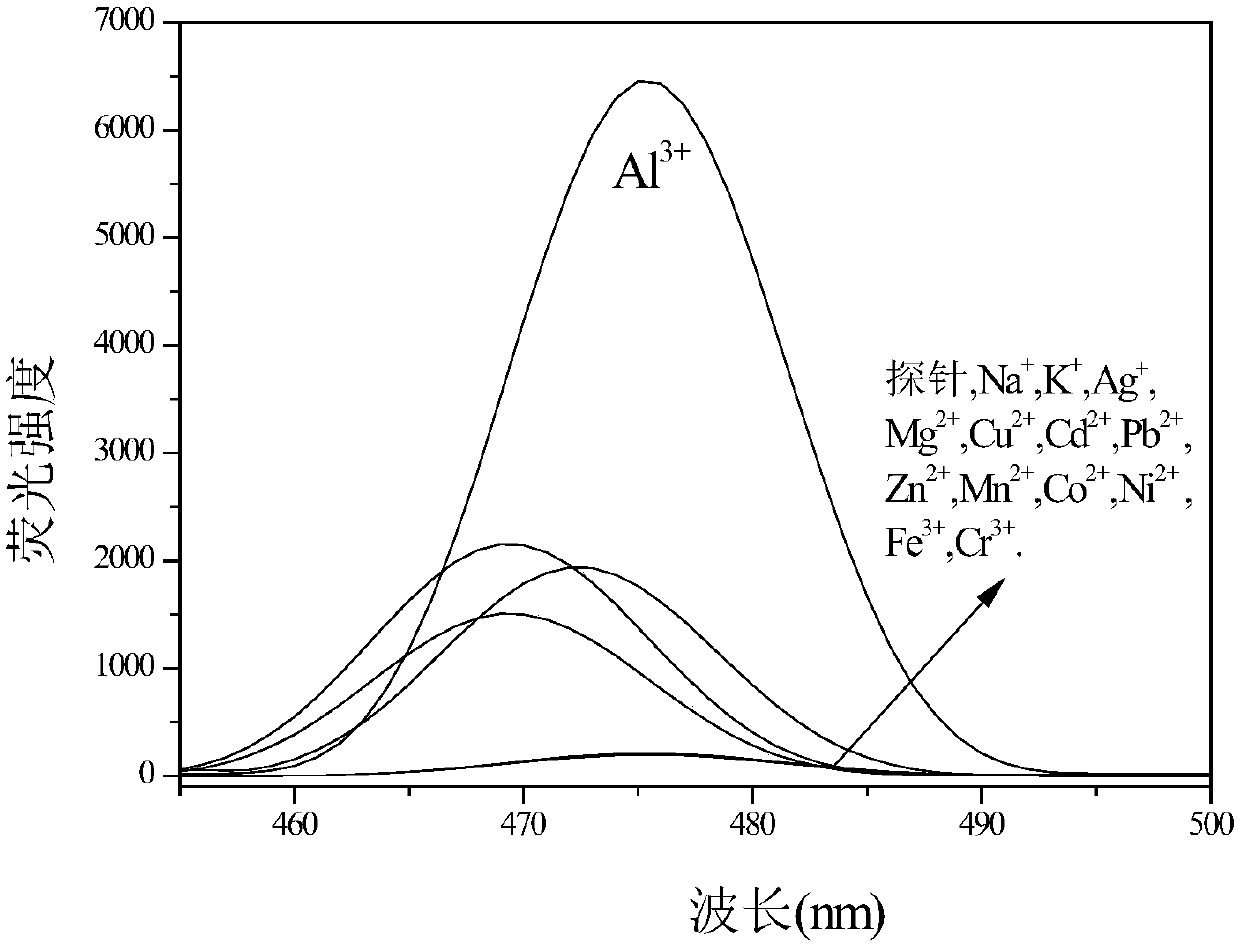Fluorescence probe compound, and preparation method and application thereof
A technology of fluorescent probes and compounds, applied in the field of fluorescent probes, can solve problems such as memory loss, damage to the central nervous system, and impact on memory, and achieve the effects of consistent reaction conditions, simple and convenient post-processing, and simple synthetic routes
- Summary
- Abstract
- Description
- Claims
- Application Information
AI Technical Summary
Problems solved by technology
Method used
Image
Examples
Embodiment 1
[0029] Embodiment 1: detect the preparation of the fluorescent probe of aluminum ion, basic synthesis process is as follows:
[0030] (1) Synthesis of 7-acetoxycoumarin (compound 2): 10mmol 7-hydroxycoumarin was added to a 100mL single-mouth bottle, 50mL chloroform was added dropwise to dissolve it, and then 10mmol acetic anhydride and 1mmol pyridine Added dropwise to compound 1 dissolved in chloroform and reacted for 6 hours to obtain a yellow clear solution, which was evaporated by rotary evaporation and separated by column chromatography to obtain compound 2 as a white solid. The eluent was petroleum ether: dichloromethane=1:4, and the yield was 85%. The proton spectrum data of gained compound 2 are as follows: 1 H-NMR (400MHz, CDCl 3 ): δ=7.69(d, J=9.6Hz, 1H), 7.49(d, J=8.4Hz, 1H), 7.11(d, J=2.1Hz, 1H), 7.05(dd, J=8.4, 2.2Hz ,1H),6.39(d,J=9.6Hz,1H),2.34(s,3H)
[0031] (2) Synthesis of 7-hydroxy-8-formyl coumarin (compound 3): at 0°C, dissolve 5 mmol of compound 2 obtain...
Embodiment 2
[0033] Embodiment 2: detect the preparation of aluminum ion fluorescent probe, basic synthesis process is as follows:
[0034](1) Synthesis of 7-hydroxy-8-formyl coumarin (compound 2): 50mmol 7-hydroxycoumarin was added in a reaction flask, and 100mL dichloromethane was added dropwise to dissolve it; then 100mmol acetic acid Anhydride and 25mmol pyridine were added dropwise to compound 1 dissolved in chloroform and reacted for 10 hours to obtain a yellow clear solution, which was evaporated by rotary evaporation and separated by column chromatography to obtain compound 2 as a white solid. The eluent was petroleum ether: dichloromethane = 1:4 , and the yield is 87%. The hydrogen spectrum data of the obtained compound 2 are as follows: 1 H-NMR (400MHz, CDCl 3 ): δ=7.69(d, J=9.6Hz, 1H), 7.49(d, J=8.4Hz, 1H), 7.11(d, J=2.1Hz, 1H), 7.05(dd, J=8.4, 2.2Hz ,1H),6.39(d,J=9.6Hz,1H),2.34(s,3H)
[0035] (2) Synthesis of 7-hydroxy-8-formyl coumarin (compound 3): at 5°C, 25 mmol of compo...
Embodiment 3
[0037] Embodiment 3: the fluorescence spectrometry of probe molecule
[0038] Get 3mL concentration among the example 1 and be the probe ethanol water mixed solution of 10 μ mol / L in the quartz cuvette, then add 3 μ L concentration respectively and be the various metal ions of 10 mmol / L (Na + , K + , Ag + ,Mg 2+ ,Cu 2+ ,Cd 2+ ,Pb 2+ ,Zn 2+ ,Mn 2+ ,Co 2+ , Ni 2+ , Fe 3+ ,Al 3+ ) solution, shake well, and measure its fluorescence emission spectrum at an excitation wavelength of 475nm (such as image 3 ), the results show that when aluminum ions are added, an emission peak occurs at 475nm, and when other metal ions are added, there is no obvious emission peak.
PUM
 Login to View More
Login to View More Abstract
Description
Claims
Application Information
 Login to View More
Login to View More - Generate Ideas
- Intellectual Property
- Life Sciences
- Materials
- Tech Scout
- Unparalleled Data Quality
- Higher Quality Content
- 60% Fewer Hallucinations
Browse by: Latest US Patents, China's latest patents, Technical Efficacy Thesaurus, Application Domain, Technology Topic, Popular Technical Reports.
© 2025 PatSnap. All rights reserved.Legal|Privacy policy|Modern Slavery Act Transparency Statement|Sitemap|About US| Contact US: help@patsnap.com



